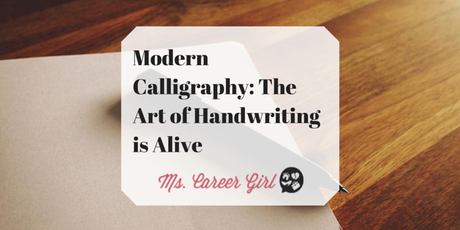
Type the phrase, “Is calligraphy dead,â€� into any search engine, and you will be certain to find a number of articles that claim it is no longer with us, but is that really true? Although you won’t find many people who still write in cursive, calligraphy’s cousin, the art of calligraphy is still very much alive and kicking.
Unlike cursive, there is no replacement for the artistic expression of calligraphy. And although many people think it is only good for wedding invitations, the many uses of this ancient art form may surprise most. Young and old alike are once again picking up the pen to create elaborate writings. The process itself is special, from choosing the right pen and ink, to picking the best paper and patterns.
Cursive as a Career
Some businesses and organizations use the services of calligraphers. Wedding planning services hire calligraphers to create invitations. Educational institutes use the services of calligraphers to create degrees and diplomas. Graphic design companies often keep a professional calligrapher’s onsite for special orders.
Many professional calligraphers work as freelancers. They advertise their services and clients hire them to create original lettered items, like official documents, invitations, business cards and more. Some calligraphers often use free wedding invitation templates as a blank canvas for creating their finished products, adding their own special touches.
Another place calligraphy is still a booming business is in our nation’s capital. The Washington Post recently reported that the White House uses the services of two staff calligraphers to create thousands of addressed invitations, envelopes, programs, signs, place cards and much more every year. The calligraphy office still uses the basic tools of calligraphy in the East Wing office, which is illuminated by natural light to help them determine the different ink colors.
In 2013, the calligraphy office produced materials for over 140 White House events, hand-addressing 10,000 envelopes for holiday greetings. Calligraphers have had the pleasure of being a part of American history, like creating a certificate for the National Medal of Arts to present to the famous children’s author, Beverly Cleary.
The Tools of the Calligrapher
Although modern fonts are a poor imitation, calligraphy is an art form, rather than just printed letters on the page. It is usually best for formal invitations, official documents, and even works of art. If you are interested in learning calligraphy, you should know the basic tools you will need, as well as techniques that are most often used.
- The Pen – The most important tool for calligraphy is the pen and there are many options for artists. Some use a cartridge pen, which lets them change out the nib or writing point. A wide nib creates large letters while a narrower nib results in smaller ones. Using a cartridge pen enable you to also change the ink, so you can change colors whenever you want. Others prefer a dip pen, which is a pen they can dip into a small pot of ink when they want to write.
- A modern option is the felt tip pen, which is convenient and easy to use because they often have one ink and two different nibs. With felt pens, you simply take off the cap and start writing without needing to use a separate ink pot, or switching out nibs. It is often helpful to have a few felt pens for calligraphy, since black ink is best for formal documents and most want to use different colors for artwork.
- The Technique – Because every nib produces a different result, practice writing with a variety of nibs on your pens. Many nib sets come with a chart to guide you, so you will know which nib is best for your purposes. Practice as much as possible, so you’ll have a better sense of which nibs and ink colors to use.
- The Balance – Basic calligraphy uses a balanced combination of ovals and lines, depending on the letter. You need to be sure to use an equal amount of space between each letter, and make sure all uppercase letters are the same height. Lowercase letters should also be the same height in order to produce an artistic and elegant piece.
- The Flow – The calligraphy ink needs to flow smoothly, so the words flow beautifully across the page. Avoid changing nibs or ink colors in the middle of a word. The words must not look choppy or written in haste. Take your time writing every word, every stroke, so that your calligraphy looks more like a work of art, than quick scribbles.
Practice Makes Perfect
As with all things, practice makes perfect, and that applies to the art of calligraphy. Read books like Modern Calligraphy: Everything You Need to Know to Get Started in Script Calligraphy and learn your craft. Start small, and don’t try to do important documents or wedding invitations until you have honed your skills. Get the right tools and take lots of time to enjoy and practice your new craft. Soon you’ll be immersed in this ancient and art form that is surely here to stay forever.
Jerry Leung is the chief designer and founder of 983invitation.com. Apart from wedding invitation and graphic design, Leung also has a great interest in architecture and the cultural aspects of weddings.

